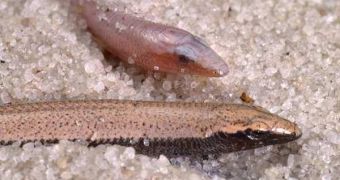In spite of being so common it's becoming annoying at times, sand is one of the most peculiar states of matter on the planet. While it may indeed not show, the stuff is able to behave like both a solid and a liquid at the same time, an ability that has made many physicists puzzle over which one of the two sands they were actually looking at. But, as scientists ponder the mysteries of the material, the sand skink continues to happily swim inside it, oblivious to the fact that, for all intents and purposes, it shouldn't be able to do that. The skink can go as far as ten centimeters deep into the sand if it wants to, while moving forward.
The thing about sand is that, to these lizards, it appears to be liquid, in that the animals use its properties for propulsion and disguise. But, at the same time, the exact same patch of sand can support the full weight of a football without deteriorating, and without the ball sinking. According to Japanese researchers at the University of Tokyo, led by scientist Takashi Shimada, the lizards are able to propel themselves forward in the sand by making use of both its solid and fluid properties at the same time.
In order to test their idea, the scientists constructed a simple computer model, which they hoped would provide them with the answers they sought. Their model features nothing more than two spheres, connected to each other through a spring. When the balls are inflated, they force the sand around them to become solid, as they increase their surface. When they deflate, they move through sand as if the material were liquid. The team's model demonstrated that, by employing a “push-me-pull-you”-type of movement, the spheres could move forward through the sand with relative ease, Technology Review reports.
The real lizards apparently have a similar ability, which allows them to inflate the back parts of their bodies, and then simply thrust their wedge-shaped heads through the sands, pushing forward through them. In addition, the skinks also employ an undulatory motion in their long bodies, whose role has not yet been fully understood. The Japanese researchers believe that this motion may also assist the animals in moving ahead. The team adds that the new study could someday result in robots that can swim under desert sands, find mines, and then disarm them.

 14 DAY TRIAL //
14 DAY TRIAL //